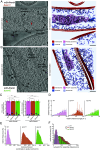In situ architecture of a nucleoid-associated biomolecular co-condensate that regulates bacterial cell division
- PMID: 39739804
- PMCID: PMC11725790
- DOI: 10.1073/pnas.2419610121
In situ architecture of a nucleoid-associated biomolecular co-condensate that regulates bacterial cell division
Abstract
In most bacteria, cell division depends on the tubulin-homolog FtsZ that polymerizes in a GTP-dependent manner to form the cytokinetic Z-ring at the future division site. Subsequently, the Z-ring recruits, directly or indirectly, all other proteins of the divisome complex that executes cytokinesis. A critical step in this process is the precise positioning of the Z-ring at the future division site. While the divisome proteins are generally conserved, the regulatory systems that position the Z-ring are more diverse. However, these systems have in common that they modulate FtsZ polymerization. In Myxococcus, PomX, PomY, and PomZ form precisely one MDa-sized, nonstoichiometric, nucleoid-associated assembly that spatiotemporally guides Z-ring formation. Here, using cryo-correlative light and electron microscopy together with in situ cryoelectron tomography, we determine the PomXYZ assembly's architecture at close-to-live conditions. PomX forms a porous meshwork of randomly intertwined filaments. Templated by this meshwork, the phase-separating PomY protein forms a biomolecular condensate that compacts and bends the PomX filaments, resulting in the formation of a selective PomXYZ co-condensate that is associated to the nucleoid by PomZ. These studies reveal a hitherto undescribed supramolecular structure and provide a framework for understanding how a nonstoichiometric co-condensate forms, maintains number control, and nucleates GTP-dependent FtsZ polymerization to precisely regulate cell division.
Keywords: bacterial cell division; biomolecular condensate; correlative cryo-electron tomography; cryo-electron microscopy; liquid-liquid phase separation.
Conflict of interest statement
Competing interests statement:The authors declare no competing interest.
Figures




Similar articles
-
Biomolecular condensate drives polymerization and bundling of the bacterial tubulin FtsZ to regulate cell division.Nat Commun. 2023 Jun 28;14(1):3825. doi: 10.1038/s41467-023-39513-2. Nat Commun. 2023. PMID: 37380708 Free PMC article.
-
The PomXYZ Proteins Self-Organize on the Bacterial Nucleoid to Stimulate Cell Division.Dev Cell. 2017 May 8;41(3):299-314.e13. doi: 10.1016/j.devcel.2017.04.011. Dev Cell. 2017. PMID: 28486132
-
PomZ, a ParA-like protein, regulates Z-ring formation and cell division in Myxococcus xanthus.Mol Microbiol. 2013 Jan;87(2):235-53. doi: 10.1111/mmi.12094. Epub 2012 Dec 19. Mol Microbiol. 2013. PMID: 23145985
-
Bacterial Nucleoid Occlusion: Multiple Mechanisms for Preventing Chromosome Bisection During Cell Division.Subcell Biochem. 2017;84:267-298. doi: 10.1007/978-3-319-53047-5_9. Subcell Biochem. 2017. PMID: 28500529 Review.
-
FtsZ ring stability: of bundles, tubules, crosslinks, and curves.J Bacteriol. 2013 May;195(9):1859-68. doi: 10.1128/JB.02157-12. Epub 2013 Mar 1. J Bacteriol. 2013. PMID: 23457247 Free PMC article. Review.
Cited by
-
Current practices in the study of biomolecular condensates: a community comment.Nat Commun. 2025 Aug 19;16(1):7730. doi: 10.1038/s41467-025-62055-8. Nat Commun. 2025. PMID: 40830340 Free PMC article.
-
In situ cryo-electron microscopy and tomography of cellular and organismal samples.Curr Opin Struct Biol. 2025 Aug;93:103076. doi: 10.1016/j.sbi.2025.103076. Epub 2025 Jun 4. Curr Opin Struct Biol. 2025. PMID: 40472449 Free PMC article. Review.
References
MeSH terms
Substances
LinkOut - more resources
Full Text Sources

